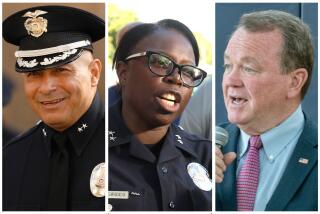Daryl Gates’ downfall
Former Police Chief Daryl F. Gates cast a long shadow, not just on the LAPD but on Los Angeles and American policing. Some of what he will be remembered for is positive: He displayed immense loyalty to the officers who served him, and for that was revered by many of them. But the largest part of his legacy remains a cautionary tale that future generations ignore at their peril.
Gates’ tumultuous tenure as chief began in 1978 and ended with his forced resignation following the 1992 Los Angeles riots. Through it all, he was an extraordinarily polarizing figure. Gates grew up poor in a Los Angeles that was a bastion of white, small-town Protestant conservatism, a sort of Peoria with palms. Joining the department in 1949 at age 23, he quickly rose through the ranks as the chauffeur and protege of William H. Parker, the department’s ironfisted chief during the 1950s and ‘60s.
World War II and the years that followed had brought a mass migration to Los Angeles of job-hungry African Americans, Jews and -- later -- Latinos. By the mid-’60s, these new arrivals were transforming the complexion and politics of the city, and coming into conflict with the LAPD. Parker reinvented the LAPD, making it a less corrupt and more professional department, but also turning it into one that was aggressive, intimidating and confrontational by design -- a small force of faceless, paramilitary cops in patrol cars policing through fear. The strategy fueled the 1965 Watts riots, which in turn caused the department to further militarize.
By the late ‘70s, when Gates became chief, social justice movements -- for civil rights, for women’s rights, for gay and lesbian rights -- were demanding full equality. Unable to understand the roots of the discontent, Gates was utterly incapable of stemming the civic unrest and alienation that followed. Instead, he became a tough-talking spokesman for fearful, tradition-bound white Americans -- a man with easy answers to complex questions battling with liberals, “cop-haters,” the media, the mayor and critical members of the City Council. He combatively ignored the pleas of L.A.’s popular black mayor, Tom Bradley, to rein in his officers. He found himself locked in bitter combat with the city’s African American community, which was crippled by crime and desperate for protection but was also enraged by its treatment at the hands of the LAPD.
Gates believed that he and the LAPD were doing the city’s most important work, and that they should be accountable to no one but themselves. His troops were arrogant and aggressive in their policing, and the cost was catastrophic. Many unarmed suspects were killed by officers, who rarely had to answer for their actions.
Among the many problems with these tactics were that they simply didn’t work. During the ‘80s, for example, violent crime in L.A. grew at more than twice the national average. In 1986, Los Angeles had the highest number of reported violent crimes per 100,000 residents and the highest number of property crimes.
Unable to control the Bloods and Crips gangs, Gates began massive South L.A. “sweeps,” in which thousands of black men were indiscriminately arrested. When Rodney King was beaten by LAPD officers, who were then acquitted for their actions, the anger finally exploded. The 1992 riots that followed lasted four days. When they were over, 45 people were dead and 2,300 were injured. Insured losses totaled $1 billion.
The cost to the department was also immense. The LAPD became a worldwide symbol of all that was bad, bigoted and brutal in big-city policing. The world, after all, had witnessed not only the beating of King on grainy footage played over and over on television but also the LAPD’s failure to react swiftly to defend the city in the first crucial hours when the rioting might have been stopped.
Astonishingly, in fact, Gates left Parker Center in the early hours of the rioting to attend a fundraiser in Brentwood aimed at defeating an upcoming police reform ballot measure. Later that year, he resigned.
Even after Gates left the department, his imprimatur lingered. His successors spectacularly failed to tame the paramilitary culture that had ossified under Gates. The rank and file was in revolt, violent crime remained horribly high, and many within the department still believed that Rodney King deserved what he got and that Daryl Gates didn’t.
It took an enormous effort to undue that mind-set. The first step was the Christopher Commission, a citizens group appointed by Bradley to examine the structure and operation of the Police Department in the wake of the King beating.
Under the chairmanship of attorney Warren Christopher, the group documented a pervasive pattern of excessive force by officers and the department’s failure to rein it in. It recommended tough new standards of accountability.
In 2000, facing a lawsuit that would have been difficult to defend, the city entered into a consent decree with the U.S. Department of Justice that required sweeping reforms. The decree came in the wake of revelations that officers in the department’s Rampart Division had engaged in a pattern of frame-ups, beatings and shootings by police officers.
In 2002, Mayor James Hahn hired reformer William J. Bratton as chief, driving a final stake through the heart of the culture Gates had embraced. It took eight years of hard work by Bratton, prodding from reform organizations such as the Advancement Project and the hiring of a diverse new police force to erase Gate’s legacy and give the LAPD back to the people of Los Angeles.
Whether we keep it depends on how well we remember the dark, stormy days of Daryl Gates.
Joe Domanick is the associate director of John Jay College’s Center on Media, Crime and Justice, and West Coast editor of TheCrimeReport.org
More to Read
Sign up for Essential California
The most important California stories and recommendations in your inbox every morning.
You may occasionally receive promotional content from the Los Angeles Times.










